Mirror
Universe
Caren
Golden Fine Art
539 West 23rd Street, New York, NY
March
20 - April 26, 2008

Spock 1, 2007, 1102 spools of thread, stainless-steel ball chain and hanging apparatus, clear acrylic sphere, metal stand (44.5 x 36 x 60 inches)
Premise: The exhibition Mirror Universe exemplifies my continued interest in the links between art and science-- in particular how consciousness and the act of seeing create the illusion of a stable, predictable, and singular universe.
Constructed from ordinary materials such as spools of thread, tightly packed chenille stems, or semi-transparent colored beads, the works in Mirror Universe merge high and low art forms, scientific concepts and TV culture, to present "reality" as a subjective experience vs. an absolute "truth."
Background: The exhibition title Mirror Universe was inspired by the 1967 Star Trek episode Mirror, Mirror in which a transporter mishap switches the crew of the Enterprise with their evil counterparts, trapping them in a "savage parallel universe." This struck a poignant chord.
Although I am not a "Trekkie," I have a vague recollection of watching reruns of the original Star Trek series in the 1970s with my father. I also watched Star Trek: The Next Generation (a.k.a. TNG) for a while in late 1980s, but I was never a fanatic until 2002, when for a few months, I began scheduling my days so I could watch reruns of Star Trek: TNG shown every afternoon on Spike TV. I remember wondering why I was so intrigued.
Eventually I realized that series Star Trek: TNG offered an escape from the tumultuous post 9-11 world by presenting a utopian perspective of humanity at its best. The mission of the TNG Enterprise was exploration and with the exception of the Borg (their defining motto was "resistance is futile"), the crew's confrontations with alien life-forms were mostly based on misunderstandings and cultural differences vs. battles between good and evil.
The idea of doing a series based on Star Trek has been gestating since that time. The concept and title for this exhibition gelled when I realized every Star Trek series had at least one episode based on the concept of a mirror or parallel universe, which fit in with my ongoing interest in the link between art and science, human perception, and subjective reality.
About Parallel Universes: "For years Parallel Universes have been a staple of science fiction. Scientists now believe there may really be a parallel universe - in fact, there may be an infinite number of parallel universes, and we just happen to live in one of them. It started when superstring theory, hyperspace and dark matter made physicists realize that the three dimensions we thought described the Universe weren't enough. By the time they had finished they'd come to the conclusion that there are eleven dimensions and that our Universe is just one bubble among an infinite number of membranous bubbles which ripple as they wobble through the eleventh dimension."- Quoted from the BBC Television Program: Parallel Universes (February, 14, 2002)
The exhibition Mirror Universe consists of conceptual and visual interpretations of characters, scenes and sets from the original Star Trek television series (1966-1969) and Star Trek: The Next Generation (1987-1994). In addition to the concept of Mirror (or Parallel) Universes, most of the works incorporate actual mirrors and can only be fully comprehended when seen reflected in the mirrors.
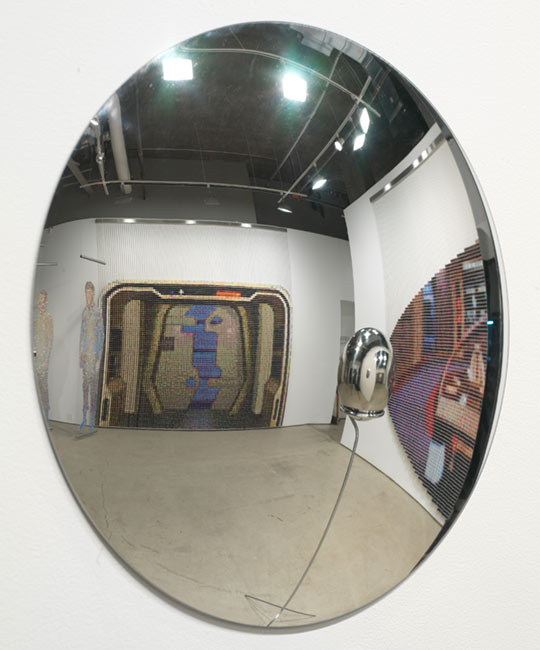
Partial installation view of Mirror Universe as seen in a convex mirror, Caren Golden Fine Art, NYC
Two large thread spool installations installed in the front gallery are interpretations/renditions of sets from the series Star Trek: The Next Generation. The three semi-transparent beaded figures hanging in front of the gallery windows are slightly larger-than-life interpretations of Captain Kirk, Spock and Dr. McCoy in the process of "beaming-in" from the original Star Trek series.
Thread Spool Installations:
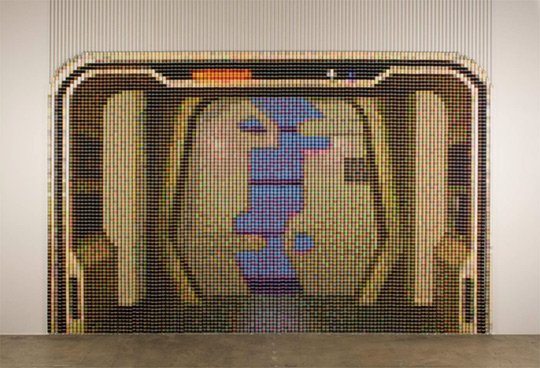
(studio view) Holodeck: Simulation Programů, 2007-2008, , *9,600 spools of thread (95 x 149 inches thread only), stainless steel ball chain and hanging apparatus, convex mirror mounted on opposing wall
The thread spool installation titled: Holodeck: Simulation Program: Chelsea, New York, 2008 is a rendition of the interior view of the Holodeck doorway and arch (TNG). This perspective places the viewer inside the holodeck (vs. outside looking in). Thus, the gallery and everything and everyone in it, as well as the city seen through the gallery windows, can be thought of as part the holodeck's virtual-simulation program. The title of this work will change with each exhibition, to reflect the time and location of each simulated Holodeck program.
Holodeck: Simulation Programů expresses my ongoing interest in presenting "reality" as a subjective experience vs. an absolute "truth" more literally than any work I have created to date. It supports the idea that "reality" is an illusion created by the human brain through unconscious processes by which raw perceptual data is input, filtered, and organized to create a holographic illusion of a solid, predictable universe.
About Holodecks : (from Wikipedia) A holodeck is a simulated reality facility located on starships and starbases in the fictional Star Trek universe. A holodeck is an enclosed room in which objects and people are simulated by a combination of replicated matter, tractor beams, and shaped force fields onto which holographic images are projected. Sounds and smells are simulated by speakers and fragranced fluid atomizers, respectively. The feel of a large environment is simulated by suspending the participants on force fields which move with their feet, keeping them from reaching the walls of the room (a virtual treadmill). Perspective is retained through use of sound damping fields and graviton lenses, which make objects, people, and sounds appear to be more distant.
The effect is an ultra-realistic simulation of an environment, with which the user can interact. User controls for a holodeck are typically located near its door (inside and out); on the inside an arch surrounds the exit and can be revealed by a user to start, modify, or stop a simulation (as seen in the thread spool installation Holodeck: Simulation Program...).
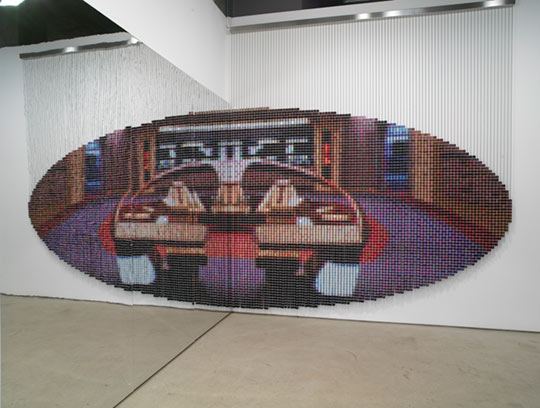
Star Trek: TNG Bridge, 2007-2008, *5,822 spools of thread (94 x 120 inches) , stainless-steel ball chain and hanging apparatus, mirror panels mounted on adjacent wall (96 x 120 x 2 inches)
Star Trek: TNG Bridge is a thread spool rendition of half of the Enterprise Bridge from Star Trek: The Next Generation series. Because the bridge is highly symmetrical, mirror panels mounted on the adjacent wall complete the illusion of the entire bridge, with the thread spool imagery appearing to continue along a single plane as it extends beyond the gallery walls. A mirrored sphere, positioned in front of the installation (not seen here), shrinks or condenses the thread spools into a seamless rendition of the bridge.
Beaded Figures (Beaming-In):
The Beaming-In beaded figures are slightly larger-than-life, beaded renditions of Captain Kirk, Spock and Dr. McCoy in various stages of "beaming-in" via transporter beams. In the front gallery, three barely-beamed-in figures hang near the gallery windows.
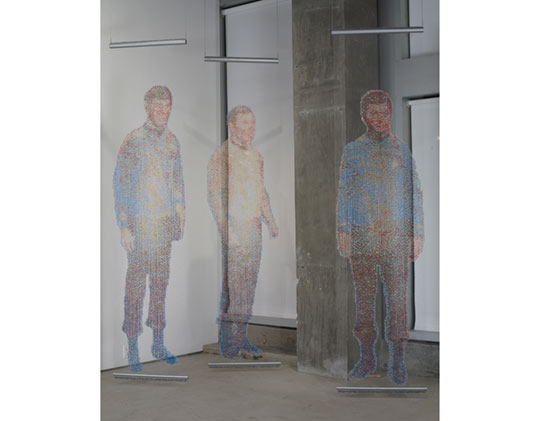
In the rear gallery, two beaded figures (Kirk and Spock) appear to be almost entirely beamed-in to a transporter set. Because viewers can only see one set of figures at a time, the Beaming-In figures can be thought of as either being in the front and rear galleries at the same time, or as beaming from one gallery to the other.

"Transporter: Kirk and Spock Beaming-In," 2007-08, 2 beaded figures hanging in front of mirror panels installed in a corner to create the illusion of 6 figures beaming in, 100,000+ loose beads on mixed medium platform (104 x 72 x 72 inches)
About the tranporter: Due to the low budget nature of the original series, Roddenberry created the transporter to avoid having to build elaborate sets for space ships or shuttles to fly towards and then land on. It was far easier and cheaper to transport the crew directly onto a planet's surface.
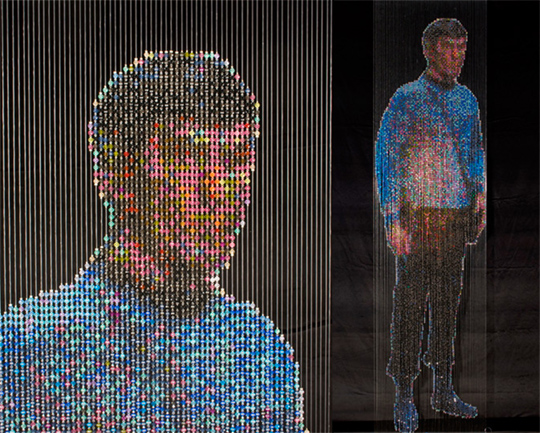
(studio view) Spock: Beaming-In, 2007, 25,000+ colored faceted
beads and silver bicone beads, monofilament, silver painted wooden
dowels
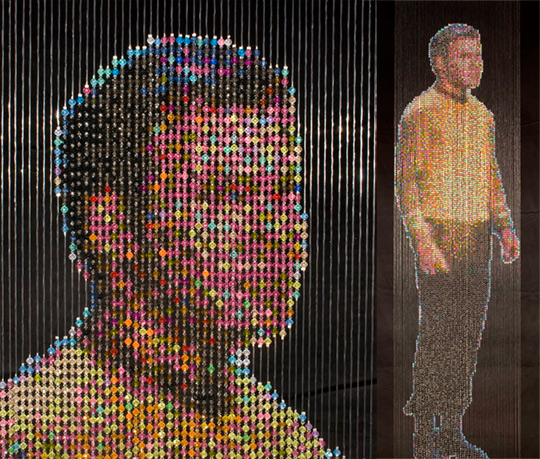
(studio
view) Captain Kirk: Beaming-In, 2007, 25,000+ colored faceted
beads and silver bicone beads, monofilament, silver painted wooden
dowels
Chenillle Stem Works:
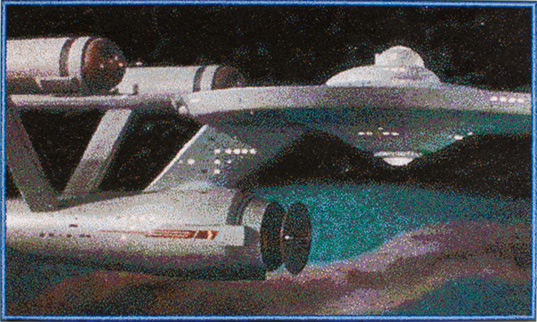
The Enterprise, 2007, 133,668 chenille stems, MDF board, 48 x
80 inches
Constructed from over 133,000 tightly-packed chenille stems, The Enterprise presents the Starship Enterprise as though it is being seen passing by the forward-viewing window from the bridge of the Starship Enterprise.
NOTE: When the chenille stem works are viewed up-close, the imagery dissolves into an odd mix of colored pixels/stems, in reference to the way images are transmitted via electronic beams to light up the 200,000+ television-screen pixels which make up the images we see while watching TV. In addition, all four stem works sparkle as light reflects off the twisted wire cores of the chenille stems.
The following three smaller chenille stem works are visual interpretations of scenes from the 1967 Star Trek episode Mirror, Mirror in which a transporter mishap switches the crew of the Enterprise with their evil counterparts, trapping them in a "savage parallel universe."
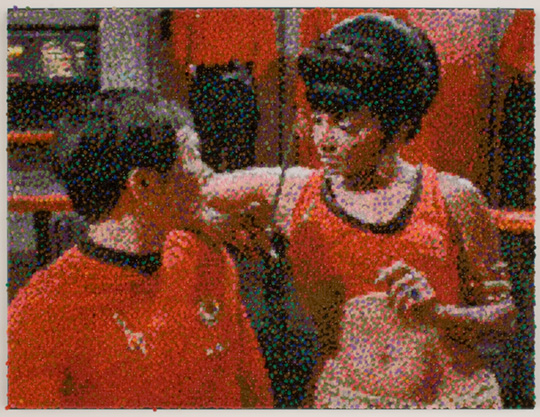
Uhura and Sulu (The game has rules), 27,648
chenille stems, MDF board (25 x 33 inches)
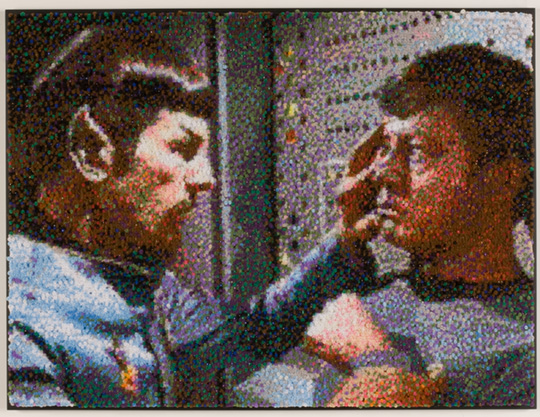
Spock and McCoy (I know what you know),
27,648 chenille stems, MDF board (25 x 33 inches)
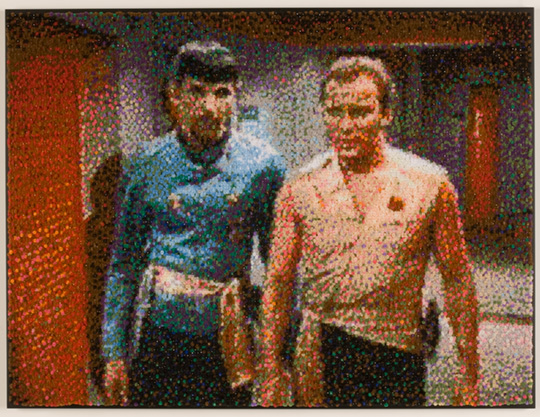
Spock and Kirk (Terror must be maintained...), 27,648 chenille
stems, MDF board (25 x 33 inches)
Spock 2 (anamorphic):
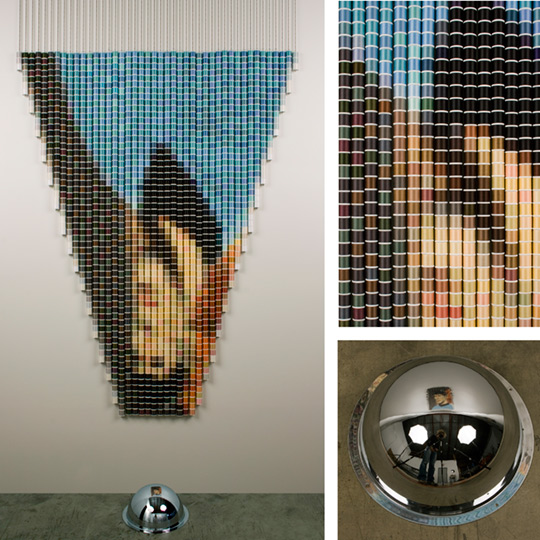
Spock 3:
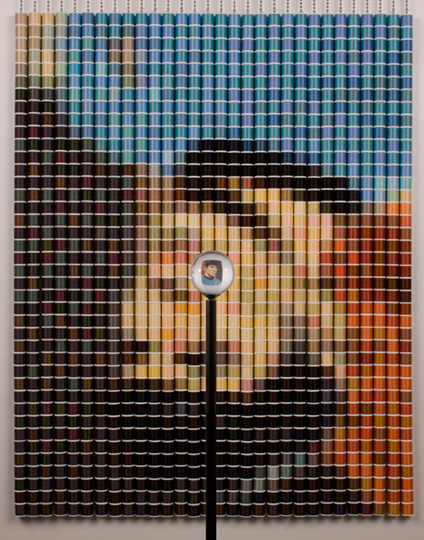
Spock 3, 2007, *1,200 spools of thread, stainless-steel ball chain and hanging apparatus, clear acrylic sphere on metal stand (47 x 37.5 x 60 inches)
Devorah Sperber is a New York-based artist whose sculptures, composed of thousands of ordinary objects, negotiate a terrain between low and high tech. Her labor-intensive works explore repetition and the effects of digital technology on perception, scale, and subjective reality. -Patricia Phillips, Executive Editor, Art Journal
© Devorah Sperber Inc. 2000